2020 Jeep Gladiator Review
 View 116 more photos
View 116 more photos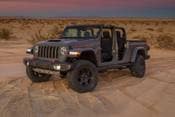 View 116 more photos
View 116 more photos View 116 more photos
View 116 more photos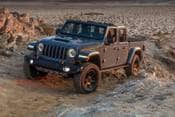 View 116 more photos
View 116 more photos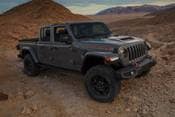 View 116 more photos
View 116 more photosWhat's new
- The Jeep Gladiator is an all-new model based on the Wrangler SUV
- Part of the first Gladiator generation introduced for 2019
2020 Jeep Gladiator Mojave Dominates Desert Dunes
A Gladiator Built for Desert Warfare
What is it?
The 2020 Jeep Gladiator revives the Mojave trim name, promising desert domination as a counterpoint to the company's traditional all-terrain crawling capabilities. In the process, the Mojave lends more credibility to the "Desert Rated" badge because it constitutes much more than just splashy graphics and an appearance package.

When the 2020 Jeep Gladiator Mojave hits showrooms this spring, it will have legitimate dune-conquering abilities. The Mojave starts with an additional inch of ground clearance over the already high-riding Rubicon, allowing for a 44.7-degree approach angle. Taking most of the abuse are specially developed Fox shocks with internal bypasses and remote reservoirs. Not surprisingly, Jeep also reinforced the frame, strengthened the axles, added hydraulic jounce bumpers, and switched to cast-iron knuckles for improved durability.
The existing 3.6-liter V6 provides power, but for now it will only be offered with the eight-speed automatic. The dual-speed transfer case is altered to better suit desert driving, allowing for speeds up to 50 mph in low range. That should help for blasting through dunes, where maintaining momentum is key. Mojave-specific ride and stability control tunings should also keep you from bogging down.
Underneath, the Mojave is fitted with numerous skid plates and sand sliders. The hood is also exclusive to the Mojave, but its scoop isn't entirely functional. It has a removable blockout panel, in case you want additional airflow on hot days, but Jeep was quick to point out that it's not really necessary. We're told that there wasn't a need to add a sand separator for the engine intake since the current location is adequate. Up front, a lightweight and removable bumper should help keep the Gladiator from augering nose first into the desert floor.
In addition to the orange Desert Rated accents and bold Mojave decals, this Gladiator also features steel-gray leather upholstery specially developed to reflect the blazing sun. That means fewer singed thighs for you and your passengers.
Why does it matter?
For decades, Jeep owners have been modding their rigs for desert duty. The new Mojave model gives shoppers an alternative that comes straight from the factory. That means it enjoys full warranty coverage; before, owners would run the risk of voiding their warranties with non-Jeep aftermarket parts. Besides that, it's just downright cool.

What does it compete with?
There aren't a lot of specially equipped trucks like the Gladiator Mojave, though most any pickup could be modded for desert intent. From the factory, the closest equivalents are the similarly priced Chevrolet Colorado ZR2 and the more expensive Ford F-150 Raptor.
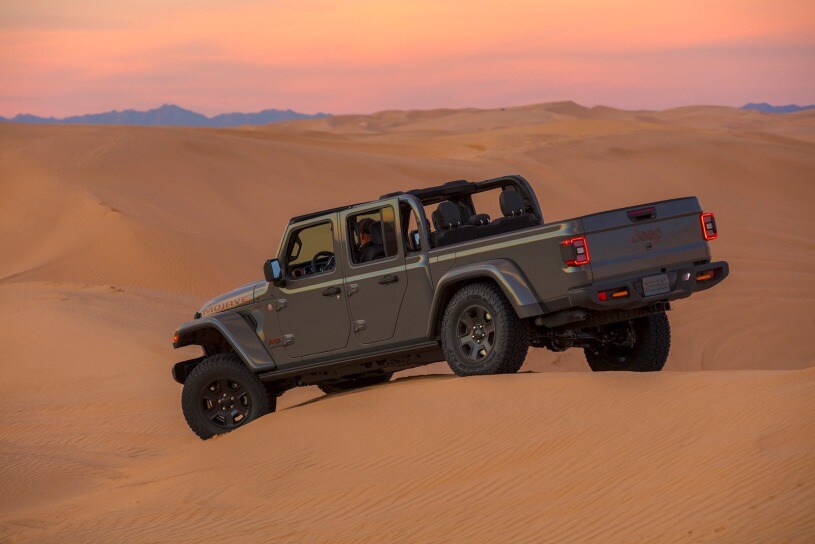
Edmunds says
It's good to see the Gladiator branch out into new territory. It's even better that the Mojave will have real equipment and features to give it true desert credentials, rather than just some fancy stickers. What a great way to live out your Baja 1000 fantasies.
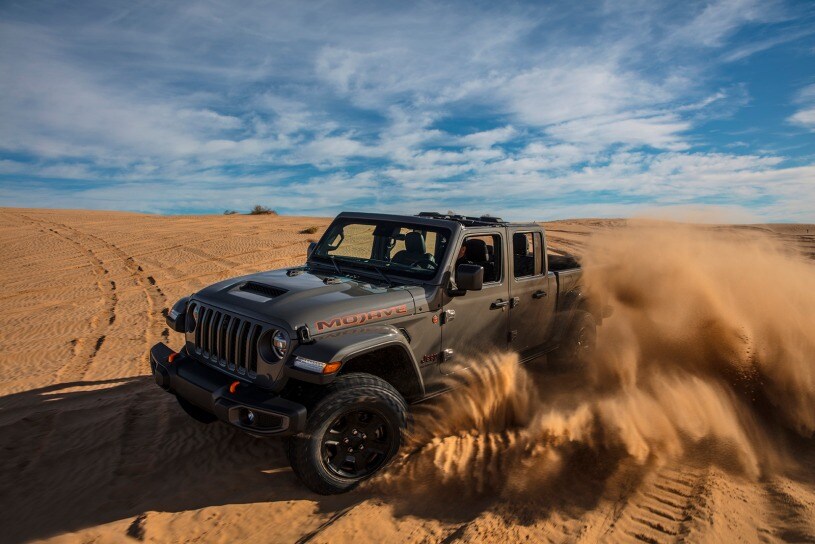
Edmunds Track Tested: 2020 Jeep Gladiator
Sure, the Wrangler-based 2020 Gladiator isn't designed for track use, but let's be honest — most Gladiators are still going to spend most of their time on the pavement. Accordingly, on-road acceleration, braking and handling should be of interest to prospective Gladiator owners, even if it's the off-road performance that gets their blood pumping. We took a Gladiator to the Edmunds test track to see how it stacks up against its less extreme midsize-truck rivals. Read on to see all of the numbers and information from our proprietary testing process, plus exclusive driving impressions from the best testing crew in the business.
2020 Jeep Gladiator Performance Testing Results
Date of test: 2/25/2019
Location: Los Angeles, CA
Odometer: 3,541
Powertrain: 3.6L V6 | 8-Speed Automatic | 4WD
Horsepower: 285 hp @ 6,400 rpm
Torque: 260 lb-ft @ 4,400 rpm
2020 Gladiator Acceleration
| Acceleration Test | Result |
|---|---|
| 0-30 mph | 2.9 sec |
| 0-45 mph | 5.2 sec |
| 0-60 mph | 8.5 sec |
| 0-75 mph | 12.9 sec |
| Quarter-mile | 16.3 sec @ 84.3 mph |
| 0-60 mph w/1 ft rollout | 8.2 sec |
"With a potent V6 and quick-shifting eight-speed automatic, the Gladiator rockets off the line with a healthy serving of torque. To get the best launch, leave the traction control system on and simply mash the throttle with the transmission in the manual gate. Shifting yourself is slower, but leaving it in manual lets the revs run all the way to redline before the computer initiates a shift."
2020 Gladiator Braking
| Braking Test | Result |
|---|---|
| 30-0 mph | 36 ft |
| 60-0 mph | 138 ft |
"Wranglers aren't known for their stopping prowess, and the Gladiator is no different. There's a bit more brake travel than you get in your typical truck or SUV, and the pedal generally feels soft and squishy. There's also very little braking feel through the pedal. When you're hard on the brakes, expect excessive amounts of brake dive, but good stability. There are some small corrections in the steering as the ABS system seeks out traction, but they don't upset the chassis."
2020 Gladiator Handling
| Handling Test | Result |
|---|---|
| Skidpad, 200-ft diameter | 0.73 g |
"All-terrain tires with big sidewalls aren't known for their on-road performance, so the Gladiator predictably has low steering feel and low lateral grip at the track. Thankfully, throttle control is excellent, allowing you to manage front end grip without relying on the slow and sluggish steering. Stability control is ever-present and cannot be fully disabled. There is moderate body roll, and you can really feel the weight transfer to the outside tires. Naturally, the Gladiator edges towards moderate understeer, though it can get up to excessive very easily. Steering weighting itself is mild, and the weight doesn't build up with load. A mild self-centering effect is more prominent."
2020 Jeep Gladiator Vehicle Details
Drivetrain
Drive Type: Four-Wheel Drive (low range)
Engine Type: Conventional Gasoline
Engine Configuration: V6
Engine Displacement (liters): 3.6
Engine Induction Type: Naturally Aspirated
Indicated Redline: 6,500
Fuel Type: 87 octane
Transmission Type: Automatic
Transmission Speeds: 8
Paddle Shifters: No
Downshift Rev Match/Throttle Blip: Yes
Holds Gears at Rev Limiter: No
Curb Weight and Weight Distribution
Curb weight as tested (lbs): 5,117
Weight L/F (lbs): 1,320
Weight L/R (lbs): 1,191
Weight R/F (lbs): 1,375
Weight R/R (lbs): 1,231
Weight distribution, front (%): 52.7
GVWR (lbs): 6,250
Brakes
ABS Type: Full ABS
Brake Rotor Type - Front: 1-Piece Disc
Brake Rotor (other) - Front: Vented
Brake Caliper Type - Front: Sliding
Brake Pistons - Front: 2
Brake Rotor Type - Rear: 1-Piece Disc
Brake Rotor (other) - Rear: Solid
Brake Caliper Type - Rear: Sliding
Brake Pistons - Rear: 1
Parking Brake: Hand
Tires
Tire pressure spec - Front: 36
Tire pressure spec - Rear: 36
Tire Make: Falken
Tire Model: WildPeak A/T AT3-W
Tire Tread: Standard
Tire Type: Regular
Tire Season: All-Season
Tire Size (sidewall) - Front: 285/70 R17 116/1130
Tire Size (sidewall) - Rear: 285/70 R17 116/1130
Spare Tire Type: Full-Size Non-Matching
-Edmunds Test Team
2020 Jeep Gladiator Rubicon on the Rubicon Trail
Rubicon: More Than Just a Name on the Side of the Hood
What is it?
The Gladiator is a midsize pickup truck based on the Jeep Wrangler SUV. And its Rubicon trim level includes items such as an upgraded transfer case, a better crawl ratio, fenders that allow for bigger tires, locking front and rear differentials, an electronically disconnectable front stabilizer bar, Fox shocks, and body-protecting rock rails and skid plates.
Go further down the trim-level-name rabbit hole and you'll find that the Rubicon is named for the Rubicon Trail. This arduous 22-mile off-road trail near Northern California's Lake Tahoe takes serious capability to traverse and, in most cases, requires heavy modification to your vehicle. For Jeep, putting the Rubicon name on a pickup truck is a big claim.
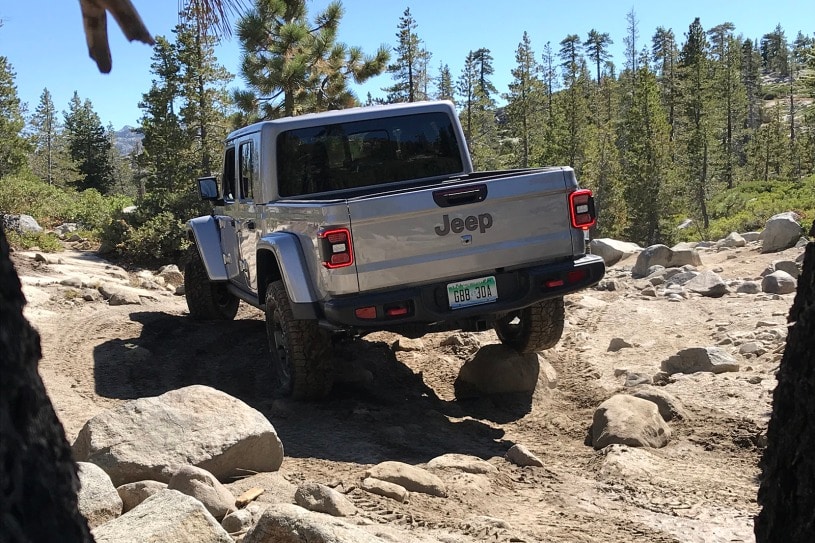
Why does it matter?
Most drivers, let alone most Jeep owners, will never see the mountains above Lake Tahoe. Even fewer will make the trek out to Loon Lake and the Rubicon trailhead. But many Jeep customers will buy a Gladiator (or a Wrangler) in Rubicon trim — and if they do, it'll be based on the promise that this thing can go just about anywhere in stock form.
Many drivers on the Rubicon Trail modify their vehicles with big lift kits and 35- or 37-inch tires. Some go so far as to remove their bumpers altogether to allow for better approach and departure angles. And most of them are in SUVs, which offer better approach and departure angles than a long, crew-cab pickup truck. The Gladiator, with its long body and 33-inch tires, is at a deficit before it ever reaches the trailhead.
Sure, the Gladiator has an insane approach angle and those 33-inch tires are the biggest stock tires Jeep has ever put on a vehicle, but it also has a longer wheelbase than a Wrangler and a big rear overhang. Those things significantly affect departure angle and breakover, putting the truck's completion of the trail in question. Can it make it through unscathed? Can it make it through at all?
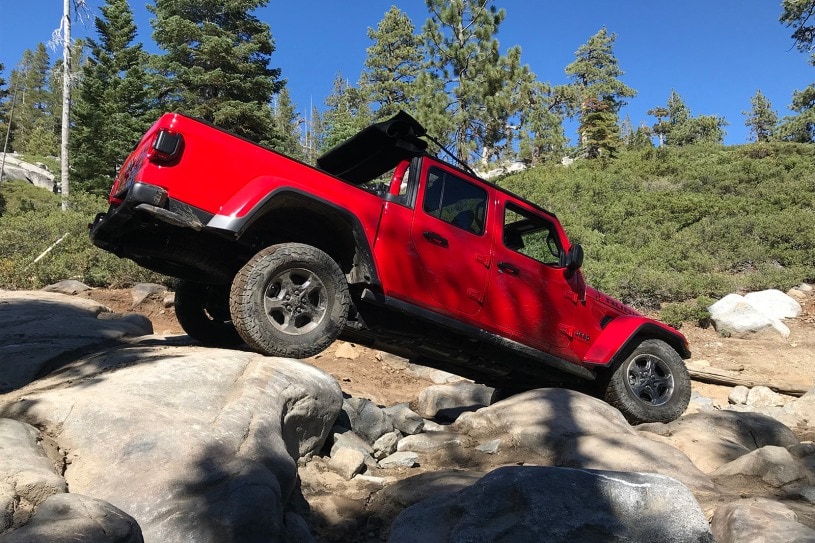
Well? Did it make it?
In a word: kinda. Our trip to the Rubicon Trail was a Jeep-organized affair. The automaker flew us out with a number of other auto writers, put us up in a hotel and paired us up with other drivers. Then, it split the trail up into two days and hired a company, Jeep Jamboree, to lead the expedition. The Jamboree folks rearranged rocks, shuffled boulders and directed us along the trail. They provided snacks, advice on when to engage the lockers and disengage the sway bars, and they walked alongside our Gladiator Rubicons as we slogged up and down the slow-going course.

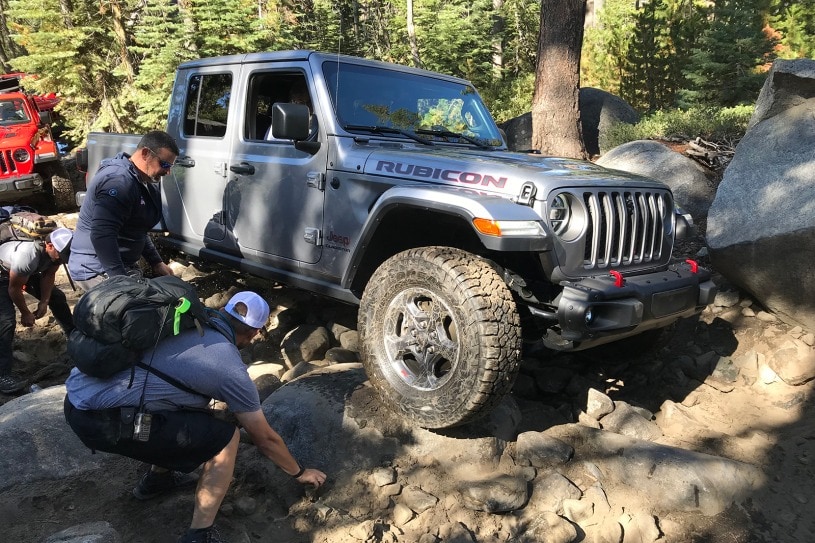
By the end of day one, we were around 6 miles into the 22-mile trail. The light was getting low and overnight temperatures were going to drop below freezing, so they airlifted all of us out. Yep, you heard that right. They landed a helicopter and picked us up, four or five at a time, and pulled us off the Rubicon Trail for the night. We went back to our plush hotel, showered, and laid our heads on expensive pillows. The next day did not go as planned.



Adverse weather conditions prevented our return. The wind, rain, clouds, and terrain meant the helicopter pilots couldn't safely deposit us back on the trail. So we completed a third of the Rubicon Trail on day one, and the second day of the trip was shot. Eventually, the Jeep Jamboree guides drove the Gladiators out under their own power, but we didn't get to see the finish line.
So can the vehicles make it? Sure. Even piloted by novice drivers, they made it out. But it required a team of over a dozen employees acting as guides and helpers. They pushed vehicles, pulled fenders, navigated boulders, and generally did all the hard work along the way as we writers just sat in the cars and ate premade sandwiches. We scraped, scratched and dented the Gladiators, proving that the truck can take a beating. We did this all while listening to satellite radio, using the heated seats and drinking ice-cold Gatorade — not exactly roughing it.
The Gladiators made it out alive, with some scratches and dents sustained along the way. I wouldn't want the fender to be hanging off my personal Jeep, nor would I want a dented muffler, scratched frame or bent tow hitch. But they made it. They lived up to the name.


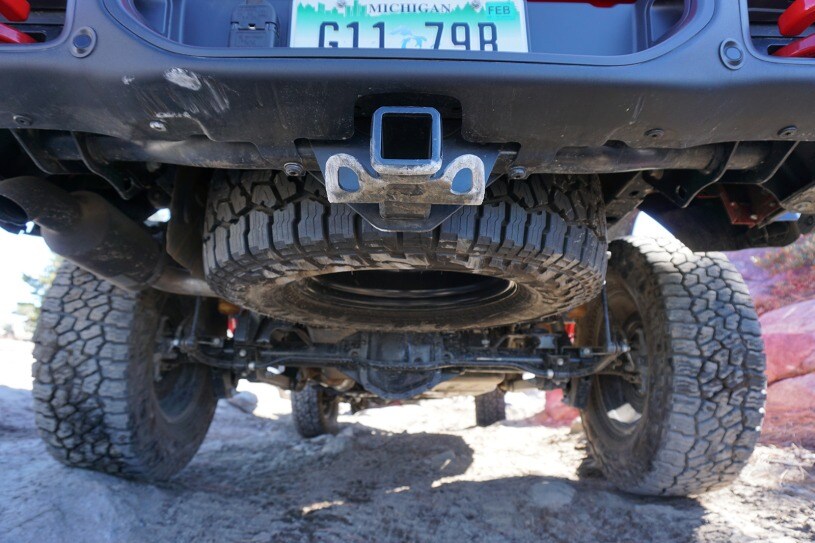
What does it compete with?
The Gladiator has a wide range of competitors, but the Rubicon's competitors are far more specific. Midsize trucks such as the Toyota Tacoma and Chevrolet Colorado are its closest rivals because they have serious off-road-focused trim levels such as the TRD Pro and the ZR2.
In our own testing, we've found the off-road trims of these midsize trucks to be plenty capable for most drivers. Even the unibody Honda Ridgeline can stand up to rutted dirt and gravel roads, although it doesn't have the clearance or hardware to compete in a place like the Rubicon Trail.
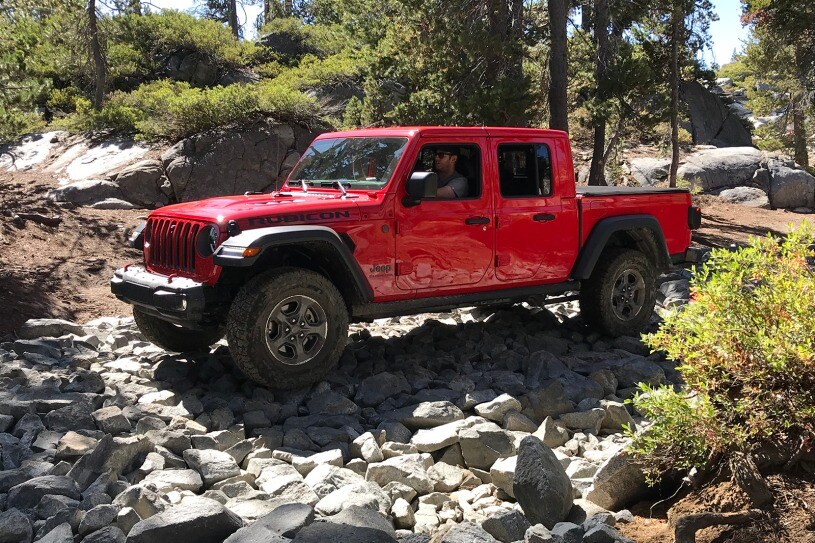
Edmunds says
Almost anywhere a Wrangler can go, the Gladiator can follow, but its lengthier dimensions mean it'll sustain more damage along the way. Despite the gauntlet of obstacles, the Gladiator Rubicon soldiered on, ready for more. Minor damage aside, this midsize pickup lived up to the Rubicon name.
2020 Jeep Gladiator First Drive
The Intersection of Want and Need
Plenty of people want a Jeep Wrangler, the ultimate go-anywhere off-road vehicle. But many buyers consistently vote with their pocketbooks that they need a pickup truck of some description. It's ridiculous to think that it took this long for Jeep to realize that the Venn diagram of these two groups might just overlap. But here we are with a Jeep pickup, the new 2020 Jeep Gladiator.
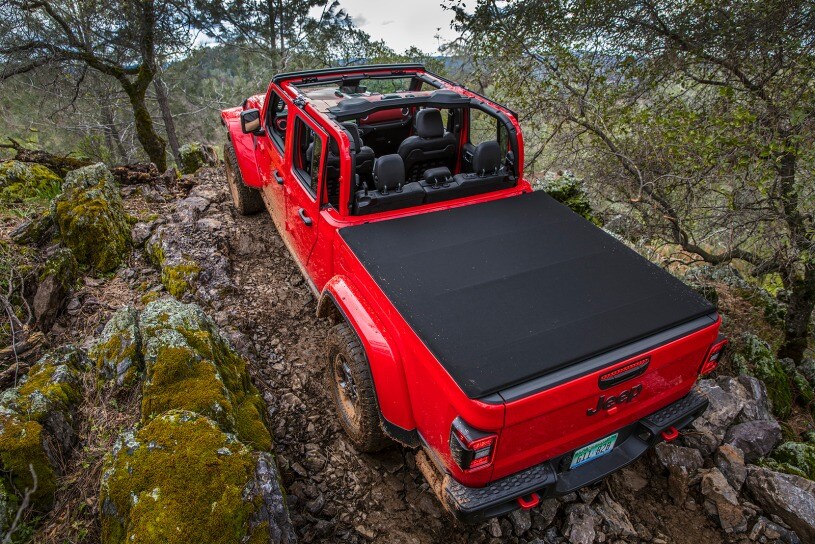
Now, there have been Jeep pickups before. The most recent example was the Cherokee-based Comanche that quietly disappeared in 1992. You have to reach back to 1985 to find the CJ-8 Scrambler, the most authentic attempt at marrying the iconic Jeep look with a truck bed. Alas, it wasn't a particularly good pickup.
Nevertheless, this image of what we'd now call a Wrangler truck got stuck in everyone's mind. Today's blueprint deviates slightly because a clear majority of both Jeep Wrangler and pickup truck buyers alike prefer four doors — a nod to multipurpose practicality over single-minded specialization. It's therefore no surprise that the midsize 2020 Jeep Gladiator is essentially a four-door Wrangler with a pickup bed grafted on. The obvious question is this: Will buyers sitting at the intersection of Want and Need get what they want out of the new Jeep Gladiator?
Tweaked Wrangler Recipe
You won't spot many differences between the Gladiator and the Wrangler Unlimited if you stand just behind either rear door and gaze forward. From that vantage point, the doors, cab, fenders, hood and even the optional hardtop's removable roof panels are identical. The same is true if you climb into the back seat and look ahead. Except for some different vehicle-shaped icons and an extra switch or two, the forward half of the Gladiator's interior is indistinguishable from a Wrangler Unlimited.
Of course, the view is entirely different if you spin around and face aft. The Gladiator's abbreviated cab is completely walled off, and behind it is a detached 5-foot (60.3 inches, to be precise) pickup bed. A big reason why the Scrambler didn't fare well as a truck — and perhaps why Jeep avoided the Scrambler name here — is that its cab and bed were a shared tub with no fixed wall to separate people from payload.
The resulting Gladiator is a legitimate midsize pickup that takes direct aim at the Chevrolet Colorado, Ford Ranger, Nissan Frontier and Toyota Tacoma. The Gladiator's most basic difference is that it comes in just one configuration: a crew cab with the short bed and four-wheel drive. There are no extended-cab, long-bed or two-wheel-drive variants. That's fine as far as we're concerned.
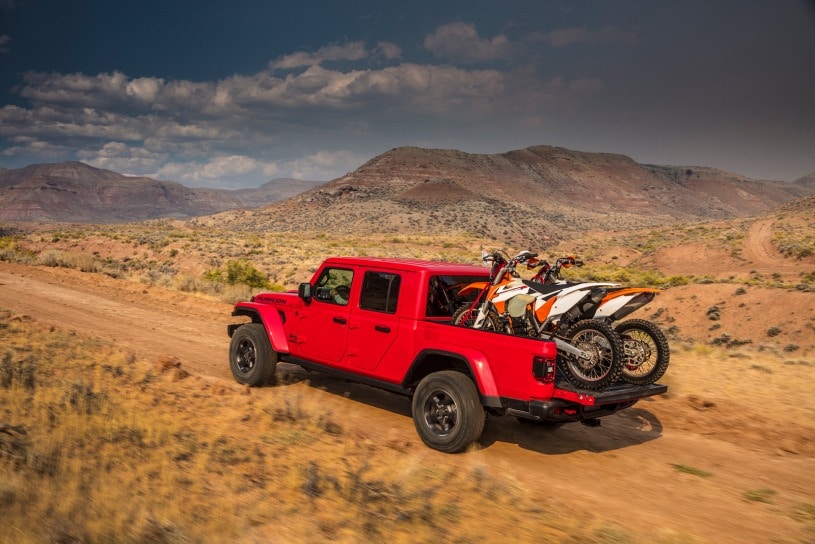
Not a Pickup Pretender
The Gladiator shares the Wrangler's solid front axle and short front overhang, and this extreme forward-axle placement results in a wheelbase that is between 9 and 10.5 inches longer than its main rival pickups and a full 18.9 inches longer than a four-door Wrangler. Even then, the rear axle crowds the cab somewhat because Jeep made the under-bed space for the spare tire big enough to hold not only the 33-inch tire that comes on a Gladiator Rubicon but also the inevitable 35-inch aftermarket upgrade some owners will retrofit.
Jeep didn't take a half-swing at making this truck functional. The Gladiator Sport has a maximum payload rating of 1,600 pounds and a maximum tow rating of 7,650 pounds. Both of these figures are best-in-class if you confine the comparison to like-minded crew-cab 4WD versions (though the Ranger's extended-cab and RWD variants can shoulder more payload). As for the Gladiator Rubicon, it can tow 7,000 pounds and carry 1,160 pounds, both of which compare favorably to the specs for the Colorado ZR2 and the Tacoma TRD Pro.
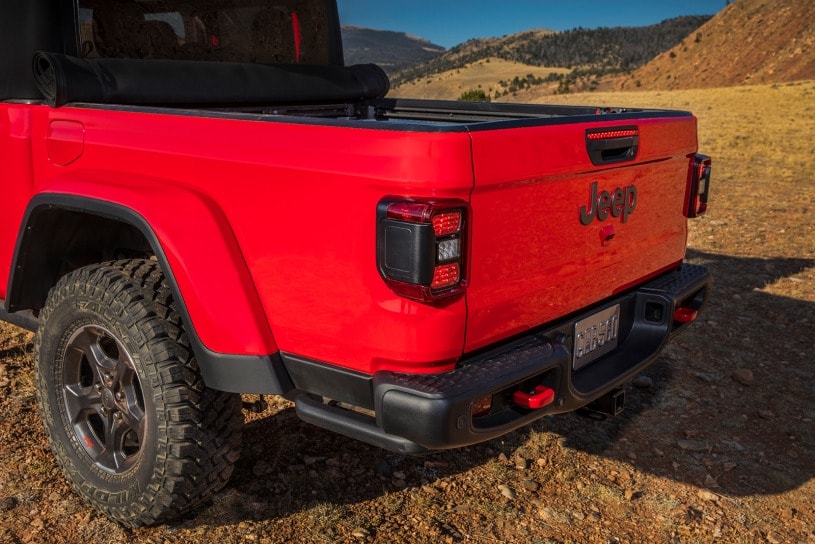
The 5-foot cargo bed also matches up well to the competition. The load floor is not overly high, and it's easy to reach in over the bed sides, which is a refreshing counterpoint to the too-tall sides of the Ranger and the Colorado. The tailgate is broad and damped, and the tailgate lock is tied into the central locking system. It also has a clever half-open position that lines up with the fender tops to better haul plywood. The Gladiator's bed comes with four tie-downs (two of which are big D-rings), and you can get a system of movable cleats or a 120-volt outlet as a factory option.
Jeep did make several changes to pull this off. Most obvious is the specialized frame, which is longer and more robust than the Wrangler's. The layout of the Gladiator's rear-axle locating links has more in common with the full-size Ram 1500 than the Wrangler, and its shock absorbers lean forward to connect to the meatiest part of the frame instead of back toward the less rigid ends. The Gladiator has larger rear disc brakes and ventilated rotors, too.
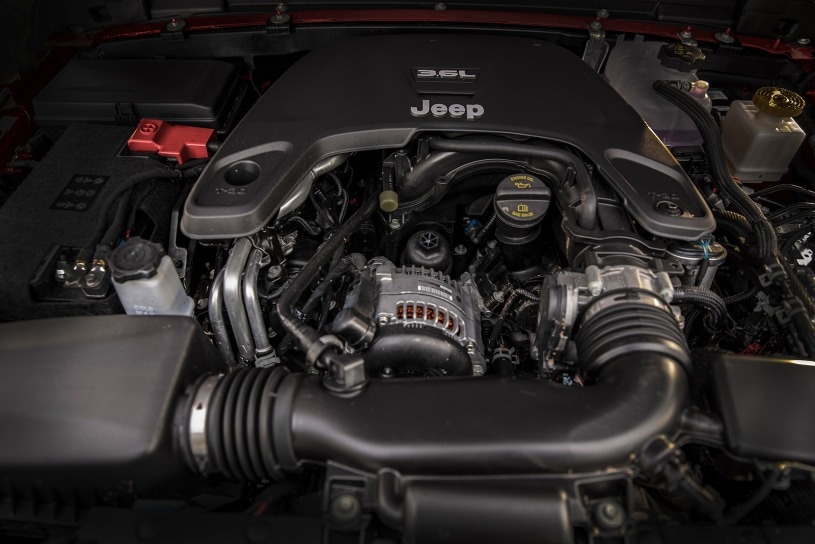
Familiar V6 Powertrain
What's not different is the 3.6-liter Pentastar V6 engine, which makes the same 285 horsepower and 260 pound-feet of torque it does in the Wrangler. The hard-working Gladiator does have a more robust cooling system and a more open grille, but the external clues are easy to miss. We had to park a Wrangler alongside to pick out what are subtle differences in Jeep's trademark seven-slot grille and its mesh. The Wrangler's 2.0-liter eTorque turbo-four is not available here, but a much torquier 3.0-liter EcoDiesel is expected within a year.
The Gladiator's transmission choices are pure Wrangler: A six-speed manual is standard across the board, and the eight-speed automatic is a $2,000 option. Rated fuel economy for a Gladiator V6 automatic is 19 mpg combined (17 city/22 highway), which is 2 mpg worse than the Wrangler and puts the Gladiator near the bottom of the midsize 4x4 pickup spectrum. As for the manual, it is also rated at 19 mpg combined (16 city/23 highway.) Get it for the fun factor and a lower buy-in, not fuel savings over the long haul.
We brought a Gladiator Rubicon to our test track to shed some light on this and see how it stacked up to a similar Wrangler Rubicon Unlimited. The Gladiator tipped the scales at 5,117 pounds, a full 572 pounds more than the Wrangler. A subsequent 0-60 mph acceleration run took 8.5 seconds, which is a half-second slower than the Wrangler. Still, the beefier Gladiator felt willing and able. As for stopping from 60 mph, the Gladiator's upgraded braking system made its extra mass disappear. Its 138-foot stop bested the Wrangler Unlimited by 3 feet.
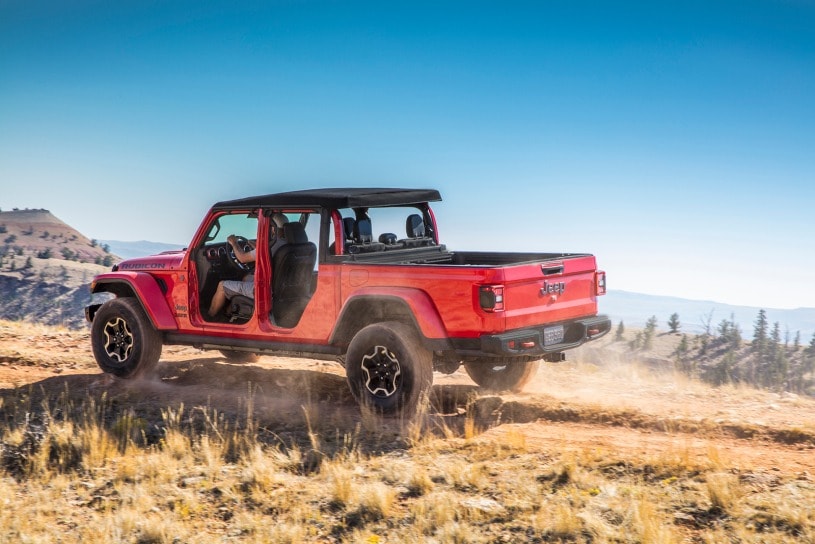
Drives Like You'd Expect, Only Better
Out on the road, the Gladiator's solid front axle and recirculating-ball steering result in a sometimes obstinate reaction to bumps. This traditional design also results in indistinct straight-line steering that worsens when there are ruts and crosswinds. It's familiar Wrangler behavior that won't bother Jeep people, but it may rankle those coming out of other midsize trucks with more modern independent front suspensions and rack-and-pinion steering.
Still, the Gladiator tracks through corners nicely, and its rear end is more settled than the Wrangler's when driving over bumps. It also excels when tackling washboard dirt roads and desert whoops. The longer wheelbase certainly has a calming effect, but the lion's share can be put down to its stiffer frame and reconfigured coil-spring rear suspension. It also doesn't hurt that the Gladiator Rubicon has aluminum-bodied Fox monotube shocks, something the Wrangler Rubicon lacks.
When the going gets really rough, that long wheelbase does demand a careful approach to breakover obstacles and tight off-road switchbacks. The Gladiator's dimensions will ultimately keep it from venturing everywhere a Wrangler can go, but we found that the practical limit is well within the expectations of a 4WD pickup. High ground clearance and an expansive central skid plate protect the important bits, and the trailing end of the bed is rimmed with rock rails that are stout enough to be used as jack points.

The Right Size for Trail Duty
Compared to other pickups, it's much easier to avoid obstacles in the Gladiator. You can readily see the trail ahead thanks to Wrangler elements such as the upright seating position, close-set windshield, and narrow hood with separate low-set fenders. The body's overall narrowness also makes it far less susceptible to scraping up against brush and trailside rocks. There's also an available forward-facing trail camera that helps you spot obstacles below the hoodline.
Of course, that narrowness does reduce potential cabin space, but the overall feel is one of coziness instead of confinement. The cockpit's logically arranged and comprehensive switchgear is close at hand, and headroom and legroom are plentiful. The back seat provides far more legroom and headroom than any of its rivals, and it folds in useful ways to haul gear. And if you ever want the feeling of infinite space, this is a true Jeep convertible. You can fold the top, detach it altogether, and even remove the doors and fold the windshield.
With the optional hardtop in place, we found the Gladiator's cabin to be unexpectedly quiet. Sure, it's not as hushed as the cabins of its permanently enclosed pickup rivals, but the difference isn't dramatic. Moreover, the Gladiator's smaller cabin enclosure isn't nearly as boomy or resonant as that of a Wrangler Unlimited. Chatting with passengers is easier, the stereo sounds crisper, and the climate control system feels more effective.

Jeep Gladiator Pricing and Availability
With one exception, the Gladiator trim strategy mirrors that of the Wrangler. The Sport and the Sport S are entry-level, and the Rubicon sits at the top. But the Wrangler's midlevel Sahara is called Overland here, which seems fair because the Gladiator is sure to be a hit with the overlanding community. Ironically, those folks will likely gravitate toward the Rubicon for its lifted suspension, taller 33-inch tires, more accommodating fenders, disconnectable front stabilizer bar, 4-to-1 low-range gearing, and lockable 4:10-to-1 front and rear differentials.
A lot of engineering and new parts went into making the 2020 Jeep Gladiator pickup, but the inevitable price increase is more affordable than expected. Add $2,000 to any 2019 Wrangler Unlimited, and you can have a comparable Gladiator. Including destination charges, a Sport starts at $35,040 and the Rubicon begins at $45,040, with the Sport S and the Overland sprinkled evenly in between. Don't forget the $2,000 it costs for the automatic, and you'll surely add even more by dipping into the familiar (and numerous) option packages.

The Gladiator will start arriving at dealerships this spring, but eager buyers can put in an online reservation for the Gladiator Launch Edition starting April 4 — also known as 4x4 Day. This special limited edition is essentially a Rubicon equipped with every available option, along with unique interior trim and badging. The price for this thoroughly loaded special edition is $62,310, including destination.
The 2020 Jeep Gladiator's extra length will surely filter out hardcore Jeep purists, but it retains more off-road capability than we expected while adding real pickup functionality. As for midsize-truck owners who always wanted a Jeep, they stand to gain more turnkey off-road performance plus a back seat that can carry actual adults. In the end, the 2020 Jeep Gladiator looks to be a runaway success when it finally lands at dealerships. Expect a traffic pileup at the corner of Want Avenue and Need Street.
2020 Jeep Gladiator First Look
Your Jeep Wrangler Pickup Is Here at Long Last
Fans of the Jeep Wrangler have been clamoring for a pickup truck version for years. Our last taste of a Jeep truck was in the 1980s when the Jeep Scrambler pickup was sold for a brief time. Aftermarket conversion kits have done a tidy business in the interim. But after the redesigned Jeep Wrangler debuted last year, the internet rumor mill started to leak hints that a proper factory-built Wrangler truck would soon be coming. Jeep was tight-lipped, but then spy photos with the unmistakable disguise-proof shape of a Wrangler pickup started popping up.
![]()
Today the long wait is finally at an end. Here at the Los Angeles Auto Show, Jeep has just pulled the wraps off the Wrangler pickup we've all been anticipating. Thing is, they've gone and called it the 2020 Jeep Gladiator instead. The name change hints at the substantial capability of this new truck. After all, the old Jeep Scrambler wasn't really that much of a pickup when it came right down to it, but the Jeep Gladiator is a fully realized midsize pickup. It can tow as much as 7,650 pounds' worth of trailer or tote as much as 1,600 pounds of payload. And it goes without saying that the Gladiator should be able to eat the competition for lunch when it comes to off-road capability.
Tell Me Your Name!
What is the Jeep Gladiator? The short answer "a Jeep Wrangler pickup" is pretty accurate. The Gladiator comes in but one configuration: 4x4 crew cab with a short bed. The front half of the so-called JT pickup is pretty much identical to the new JL Wrangler four-door. And that sameness stretches all the way back to the rear doors and the positioning of the rear seats relative to the fronts. The dash, the switchgear, and the front three-quarters of the interior are indistinguishable, and the same can be said for much of the front sheet metal.
All 2020 Gladiators will be powered by the Wrangler's familiar 3.6-liter Pentastar V6 engine that makes 285 horsepower and 260 pound-feet of torque. The turbocharged 2.0-liter eTorque engine will not be offered, but a 3.0-liter EcoDiesel V6 that makes a monstrous 442 lb-ft of torque is in the pipeline for late next year. Just like the Wrangler, a six-speed manual is standard and an eight-speed automatic is optional. As for the diesel, the automatic will be the only choice when it finally arrives.
There are four familiar trim configurations: Sport, Sport S, Overland and Rubicon. The Overland takes the place of the Sahara, but it's pretty much the same thing. Like the Wrangler, you can choose between a folding soft top or a three-piece hardtop with Freedom panels. Both tops can be completely removed, as can all four doors, and the front windshield can be folded flat over the hood.

Strength and Honor
The front end of the Gladiator may be very familiar, but turn around and you'll see a back half that's entirely new. The cab and rear window have been walled off, and behind that there's a 5-foot-long truck bed. The rear seat bottoms flip up to reveal storage compartments, or you can fold the seatbacks down to create a flat — if somewhat elevated — load surface.
The spare tire isn't visible because it hangs underneath between the frame rails, like on other trucks, making room for a full-featured, high-strength steel bed that is set up to do truck things well. There are two large swiveling D-ring tie-downs up front, a pair of fixed ones in back, and a 120-volt power outlet in a rear corner. A system of nicely integrated movable cleats is available for the front and sides, and the damped tailgate has a midway-open position that lines up with the fender tops to support plywood sheets flat.
![]()
The frame has been lengthened and strengthened to make it all work. The extra strength helps the Gladiator achieve what Jeep says are class-leading towing and payload ratings of 7,650 pounds and 1,600 pounds, respectively. The class in question is the hotly contested gasoline-powered crew-cab 4x4 division. But it is worth mentioning that the upcoming Ranger and even the Tacoma can be configured to shoulder more payload in certain extended-cab and 4x2 configurations that aren't part of the Gladiator lineup.
As for the extra frame length, that's what it takes to mount a fully functional 5-foot bed behind the seating package defined by the Wrangler's interior dimensions. Thus, the Gladiator's wheelbase is 19 inches longer than that of the four-door Wrangler. At first glance, that doesn't sound unreasonable. But the fact is the resulting 137.3-inch wheelbase is between 9 to 12 inches longer than similar crew-cab short-bed versions of the Colorado, Ranger and Tacoma. The Gladiator's very short front overhang offsets this somewhat in terms of overall garageable length, but it is still almost 6 inches longer from stem to stern than a similar Tacoma.
![]()
People Should Know When They're Conquered
The Wrangler's legendary off-road capability goes well beyond the usual traction-control-software-and-lifted-ride-height formula basic modern off-road vehicles rely on. We'd be doing the Gladiator a serious disservice if we didn't perform a deep dive into the engineering that will make it a dominant off-road midsize-truck competitor. So brace yourself ... or just skip ahead a few paragraphs.
It turns out the Gladiator's long wheelbase is bad news when it comes to the off-road breakover angle. The Gladiator offsets this somewhat with superior ground clearance compared to rivals, but the breakover is still just 18.4 degrees on Sport and Overland variants, with the jacked-up Rubicon good for 20.3 degrees. Meanwhile, the popular Tacoma 4x4 has 24 degrees of breakover clearance. On this basis alone, we predict a strong market for Gladiator skid plates, lift kits and oversize tires.
But the Gladiator does have the other trucks covered in terms of approach angle and departure angle, and its advantage is so huge it's not even worth taking the time to list all the comparisons out. And this comes before we start talking about the rough-and-ready Rubicon, which stands even taller on its 33-inch tires and mildly lifted suspension. Jeep says 35-inch aftermarket-sourced tires will fit within the fenders without a lift, and the automaker's eager to point out that the frame rails are spaced apart far enough to accommodate a matching 35-inch spare underneath.
Of course, the Gladiator has the same solid front and rear axle configuration of a Wrangler, but the greater loads associated with towing and hauling require beefier running gear. All versions from Sport on up use third-generation Dana 44 axles, front and rear. Additionally, the Gladiator gets beefier rear brakes, and the rear axle's suspension link geometry has been altered. The Gladiator's rear shock absorbers tilt forward ahead of the axle instead of pointing aft behind. This more favorable orientation should deliver a smoother ride because it directs the loads toward the middle of the vehicle, something that's not possible on a Wrangler because its rear seat is too close to the axle. Interestingly, the shocks on the Gladiator Rubicon are Fox aluminum-bodied monotube units, something we haven't seen on the Wrangler Rubicon.
Taken altogether, the Gladiator looks like it will debut as a top contender in the off-road midsize-truck market. Still, a head-to-head test with the Colorado ZR2, the Tacoma TRD Pro and (eventually) the Ranger Raptor is definitely in order.
![]()
Jeep Gladiator Pricing and Release Date
The Jeep Gladiator pickup truck is set to go on sale sometime in spring 2019, and our first chance to drive one will most likely coincide with the Easter Jeep Safari in Moab. But Jeep is not ready to share pricing just yet. From the sheer size of it and extra parts involved, the Gladiator can only be more expensive than a four-door Wrangler Unlimited. One of those costs $33,040 in Sport trim and $43,040 in Rubicon form with no options and a manual transmission. It's hard to guess how much more expensive the Gladiator will be, but it's easy to imagine a price at least $4,000 or so higher. That would make the starting price of a 2020 Jeep Gladiator about $37,000.
The bottom line is that the Jeep Gladiator is a formidable-looking truck from a legendary brand going head on against the midsize-truck establishment. We thought things were heating up with the impending return of the much-anticipated Ford Ranger, but the arrival of a true Jeep pickup is sure to upset the status quo. It's a very good time to be a midsize-truck buyer.
Notably, we picked the 2020 Jeep Gladiator Rubicon as one of Edmunds' Best Off-Road Trucks for this year.
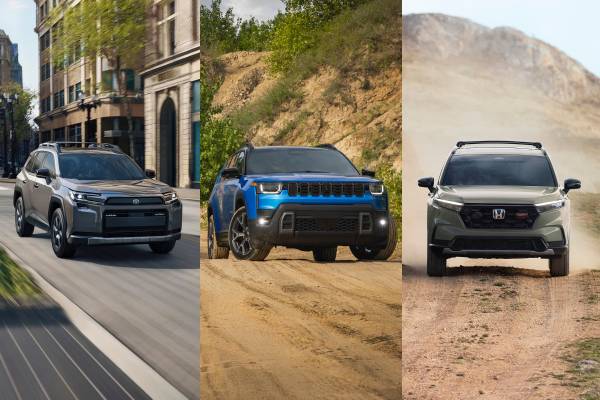
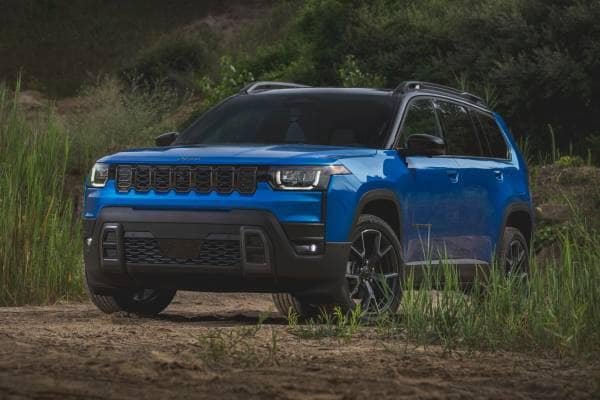
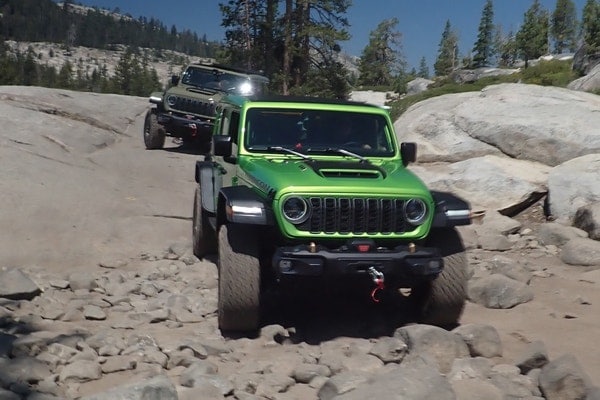
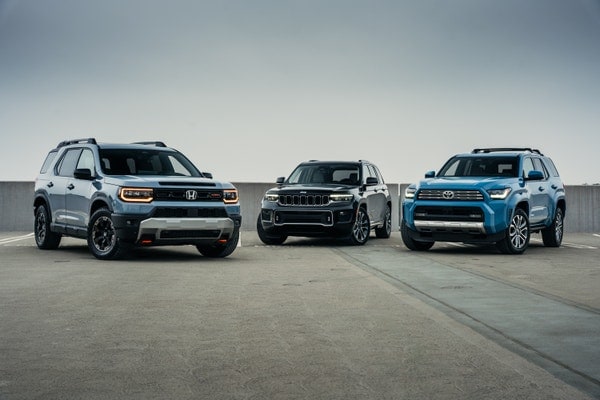
Cost to Drive
Jeep Gladiator Owner Reviews
Most Helpful Owner Reviews
Trending topics
Finally -the Best of Both Worlds
4 out of 5 starsImpressed
5 out of 5 starsLot of Engine Problems
1 out of 5 starsDon’t think about it, buy it!
5 out of 5 stars2020 Jeep Gladiator videos
2020 Jeep Gladiator Rubicon vs. 2020 Toyota Tacoma TRD Pro - Truck Tug of War
 2020 Jeep Gladiator Rubicon vs. 2020 Toyota Tacoma TRD Pro -...
2020 Jeep Gladiator Rubicon vs. 2020 Toyota Tacoma TRD Pro -... 2020 Jeep Gladiator vs. 2020 Toyota Tacoma - Off-Road Truck ...
2020 Jeep Gladiator vs. 2020 Toyota Tacoma - Off-Road Truck ... 2020 Jeep Gladiator Off-Road in Moab at the Easter Jeep Safa...
2020 Jeep Gladiator Off-Road in Moab at the Easter Jeep Safa... Jeep Gladiator Rubicon vs. Chevy Colorado ZR2: 2019 Off-Road...
Jeep Gladiator Rubicon vs. Chevy Colorado ZR2: 2019 Off-Road... Jeep Gladiator vs. Jeep Wrangler: Comparison Test
Jeep Gladiator vs. Jeep Wrangler: Comparison Test 2020 Jeep Gladiator First Look | LA Auto Show
2020 Jeep Gladiator First Look | LA Auto Show
2020 Gladiator Highlights
| Base MSRP Excludes Destination Fee | $33,545 |
|---|---|
| Engine Type | Gas |
| Combined MPG | 19 MPG |
| Cost to Drive | $186/month |
| Seating | 5 seats |
| Drivetrain | four wheel drive |
| Max Towing Capacity | 7,650 lbs. |
| Warranty | 3 years / 36,000 miles |
Safety
Our experts like the Gladiator models:
- Collision Warning Plus
- Alerts the driver about an imminent forward collision. Can apply the brakes automatically if the driver doesn't react in time.
- Blind-Spot Monitor w/Cross-Traffic Alert
- Warns the driver of other cars in the blind spot and approaching cars from out of the driver's view while in reverse.
- Rear Parking Sensors
- Gives audio alerts when approaching objects from the rear, helping to minimize low-speed bumps in parking scenarios.
NHTSA Overall Rating
- Frontal Barrier Crash RatingOverall4 / 5Driver4 / 5Passenger5 / 5
- Side Crash RatingOverallNot Rated
- Side Barrier RatingOverallNot RatedDriverNot RatedPassengerNot Rated
- Combined Side Barrier & Pole RatingsFront SeatNot RatedBack SeatNot Rated
- RolloverRollover3 / 5Dynamic Test ResultNo TipRisk Of Rollover26.7%
People who viewed this also viewed
| 1.0 average Rating out of 1 reviews. |
| Starting at $32,095 |
| 4.4 average Rating out of 9 reviews. |
| Starting at $33,350 |
| 4.6 average Rating out of 8 reviews. |
| Starting at $31,590 |
Related Used 2020 Jeep Gladiator info
Vehicle reviews of used models
- Subaru Crosstrek 2021 Review
- BMW 8 Series Gran Coupe 2021 Review
- Audi A3 2020 Review
- Toyota Sequoia 2021 Review
- Hyundai Kona Electric 2021 Review
Shop similar models
- Used Ram 1500 2025
- Used Nissan Frontier 2025
- Used Toyota Tacoma 2025
- Used Chevrolet Silverado-3500hd 2025
Shop used vehicles in your area
Popular new car reviews and ratings
- New BMW 7 Series
- Kia Niro 2025
- 2026 X5
- 2026 GV70
- Toyota Corolla Cross 2024
- 2026 Toyota 4Runner News
- New Toyota Land Cruiser
- Alfa Romeo Stelvio 2025
- 2025 Volvo S60
- 2025 Elantra N
Research other models of Jeep
- 2025 Grand Cherokee
- New Jeep Wrangler
- 2025 Gladiator
- New Jeep Gladiator
- 2025 Jeep Compass
- 2025 Grand Cherokee L
- Jeep Grand Wagoneer 2025
- 2024 Jeep Grand Cherokee
- 2025 Jeep Wagoneer L
Research similar vehicles
Other models
- Used Mercedes-Benz E-Class in Zachary, LA 2025
- Used Infiniti M56 in Denham Springs, LA 2011
- Used Chevrolet Blazer in West Somerset, KY 2025
- New Toyota Corolla-Cross-Hybrid for Sale in Cambridge, OH
- Used Subaru Solterra in Norwood, MA 2025
- Used Lexus Rz-450E in Ypsilanti, MI 2023
- Used Nissan Nv-Passenger in Beaver Falls, PA 2021
- Used Pontiac Montana in Cocoa, FL 2005
- Used Dodge Neon in Roslindale, MA 2005
- New Audi Q5-Sportback for Sale in Elmont, NY